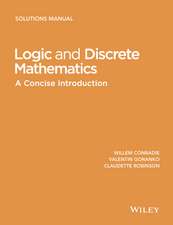A Guide to Classical and Modern Model Theory: Trends in Logic, cartea 19
Autor Annalisa Marcja, Carlo Toffalorien Limba Engleză Paperback – 30 iun 2003
This volume:
-is easily accessible to young people and mathematicians unfamiliar with logic;
-gives a terse historical picture of Model Theory;
-introduces the latest developments in the area;
-provides 'hands-on' proofs of elimination of quantifiers, elimination of imaginaries and other relevant matters.
A Guide to Classical and Modern Model Theory is for trainees and professional model theorists, mathematicians working in Algebra and Geometry and young people with a basic knowledge of logic.
Din seria Trends in Logic
-
 Preț: 365.81 lei
Preț: 365.81 lei -
 Preț: 361.11 lei
Preț: 361.11 lei - 18%
 Preț: 1225.48 lei
Preț: 1225.48 lei - 18%
 Preț: 959.50 lei
Preț: 959.50 lei - 15%
 Preț: 646.94 lei
Preț: 646.94 lei - 15%
 Preț: 636.27 lei
Preț: 636.27 lei - 18%
 Preț: 1387.73 lei
Preț: 1387.73 lei - 15%
 Preț: 644.82 lei
Preț: 644.82 lei - 15%
 Preț: 646.75 lei
Preț: 646.75 lei - 15%
 Preț: 636.12 lei
Preț: 636.12 lei - 15%
 Preț: 647.40 lei
Preț: 647.40 lei - 15%
 Preț: 641.03 lei
Preț: 641.03 lei -
 Preț: 385.47 lei
Preț: 385.47 lei - 18%
 Preț: 960.42 lei
Preț: 960.42 lei - 18%
 Preț: 956.18 lei
Preț: 956.18 lei - 18%
 Preț: 952.09 lei
Preț: 952.09 lei - 20%
 Preț: 1276.86 lei
Preț: 1276.86 lei - 18%
 Preț: 951.14 lei
Preț: 951.14 lei - 15%
 Preț: 643.00 lei
Preț: 643.00 lei - 15%
 Preț: 644.49 lei
Preț: 644.49 lei - 18%
 Preț: 1845.48 lei
Preț: 1845.48 lei - 18%
 Preț: 953.65 lei
Preț: 953.65 lei - 15%
 Preț: 635.47 lei
Preț: 635.47 lei - 18%
 Preț: 894.79 lei
Preț: 894.79 lei - 24%
 Preț: 1205.41 lei
Preț: 1205.41 lei - 15%
 Preț: 635.80 lei
Preț: 635.80 lei
Preț: 733.03 lei
Preț vechi: 893.93 lei
-18% Nou
Puncte Express: 1100
Preț estimativ în valută:
140.26€ • 146.45$ • 116.09£
140.26€ • 146.45$ • 116.09£
Carte tipărită la comandă
Livrare economică 05-19 aprilie
Preluare comenzi: 021 569.72.76
Specificații
ISBN-13: 9781402013317
ISBN-10: 1402013310
Pagini: 384
Ilustrații: XI, 371 p.
Dimensiuni: 160 x 240 x 20 mm
Greutate: 0.6 kg
Ediția:2003
Editura: SPRINGER NETHERLANDS
Colecția Springer
Seria Trends in Logic
Locul publicării:Dordrecht, Netherlands
ISBN-10: 1402013310
Pagini: 384
Ilustrații: XI, 371 p.
Dimensiuni: 160 x 240 x 20 mm
Greutate: 0.6 kg
Ediția:2003
Editura: SPRINGER NETHERLANDS
Colecția Springer
Seria Trends in Logic
Locul publicării:Dordrecht, Netherlands
Public țintă
Professional/practitionerCuprins
Structures.- 1.1 Structures.- 1.2 Sentences.- 1.3 Embeddings.- 1.4 The Compactness Theorem.- 1.5 Elementary classes and theories.- 1.6 Complete theories.- 1.7 Definable sets.- 1.8 References.- Quantifier Elimination.- 2.1 Elimination sets.- 2.2 Discrete linear orders.- 2.3 Dense linear orders.- 2.4 Algebraically closed fields (and Tarski).- 2.5 Tarski again: Real closed fields.- 2.6 pp-elimination of quantifiers and modules.- 2.7 Strongly minimal theories.- 2.8 o-minimal theories.- 2.9 Computational aspects of q. e.- 2.10 References.- Model Completeness.- 3.1 An introduction.- 3.2 Abraham Robinson’s test.- 3.3 Model completeness and Algebra.- 3.4 p-adic fields and Artin’s Conjecture.- 3.5 Existentially closed structures.- 3.6 DCF0.- 3.7 SCFp and DCFp.- 3.8 ACFA.- 3.9 References.- Elimination of imaginaries.- 4.1 Interpretability.- 4.2 Imaginary elements.- 4.3 Algebraically closed fields.- 4.4 Real closed fields.- 4.5 The elimination of imaginaries sometimes fails.- 4.6 References.- Morley rank.- 5.1 A tale of two chapters.- 5.2 Definable sets.- 5.3 Types.- 5.4 Saturated models.- 5.5 A parenthesis: pure injective modules.- 5.6 Omitting types.- 5.7 The Morley rank, at last.- 5.8 Strongly minimal sets.- 5.9 Algebraic closure and definable closure.- 5.10 References.- ? -stability.- 6.1 Totally transcendental theories.- 6.2 ?-stable groups.- 6.3 ?-stable fields.- 6.4 Prime models.- 6.5 DCF0 revisited.- 6.6 Ryll-Nardzewski’s Theorem, and other things.- 6.7 References.- Classifying.- 7.1 Shelah’s Classification Theory.- 7.2 Simple theories.- 7.3 Stable theories.- 7.4 Superstable theories.- 7.5 ?-stable theories.- 7.6 Classifiable theories.- 7.7 Shelah’s Uniqueness Theorem.- 7.8 Morley’s Theorem.- 7.9 Biinterpretability and Zilber Conjecture.- 7.10 Two algebraicexamples.- 7.11 References.- Model Theory and Algebraic Geometry.- 8.1 Introduction.- 8.2 Algebraic varieties, ideals, types.- 8.3 Dimension and Morley rank.- 8.4 Morphisms and definable functions.- 8.5 Manifolds.- 8.6 Algebraic groups.- 8.7 The Mordell-Lang Conjecture.- 8.8 References.- O-minimality.- 9.1 Introduction.- 9.2 The Monotonicity Theorem.- 9.3 Cells.- 9.4 Cell decomposition and other theorems.- 9.5 Their proofs.- 9.6 Definable groups in o-minimal structures.- 9.7 O-minimality and Real Analysis.- 9.8 Variants on the o-minimal theme.- 9.9 No rose without thorns.- 9.10 References.
Caracteristici
Includes supplementary material: sn.pub/extras

















